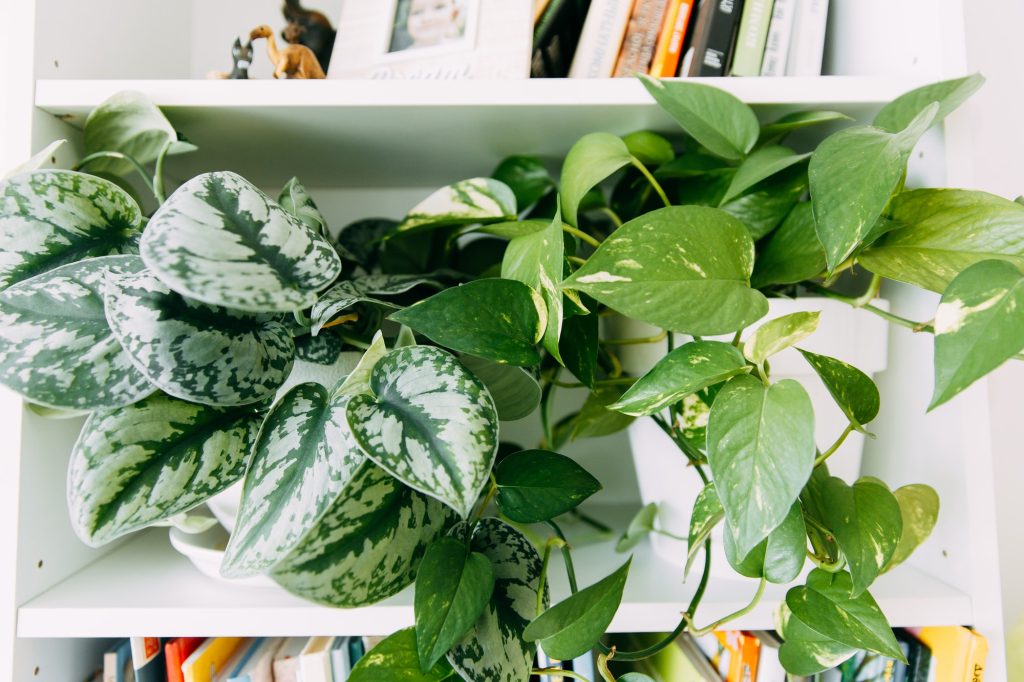House plant growers keen on propagating the Scindapsus plant find it challenging to select a choice, especially at nurseries because the varieties of the Scindapsus plant share similar features with some varieties of the Pothos plant. It can be somewhat confusing seeing similar plants from different families or origins.
Asides from the dilemma their growers face in identifying, this plant is a low maintenance plant that requires adequate care and attention.
They can survive just a little neglect especially if they are mature, although not for an extended period. It is not only widely recognized for its wide leaves and bushy leaves, but it is also appreciated for its crawling and climbing ability.
While some growers prefer their Scindapsus plant to be pruned to a normal house plant shape, others like theirs to grow into trails for aesthetic effect in the home or covers for garden walls.
With the list provided below, you have 6 options of Scindapsus varieties to kick-start your propagation journey. In addition, we have provided tips that would aid you all through your propagation and tending journey.
[NEW] Tradescantia Varieties: 10 Common And Rare Types
Scindapsus Plant Basic Information and Care
Most of the Scindapsus plant varieties share similar growth needs. Note that even though they share similar growth requirements, some of their varieties require the lesser or greater provision of these requirements than other varieties.
| Botanical name | Epipremnum pinnatum |
| Light | Bright indirect light |
| Watering | Moderate watering |
| Temperature | 65°F-75°F |
| Toxicity | Toxic to pets and humans |
| Food | Liquid house plant fertilizer |
| Humidity | Low humidity |
| Foliage color | Green, Silver, and White |
| Susceptible Plant Issues | Root rot, Yellow/ Brown / Dried Leaves, Pest Infestations. |
The following are tips you would need while nurturing your Scindapsus plant:
- Mist the leaves regularly; this includes both the upper and underside leaves
- For an appealing and organized outlook, attach crawling plants to a pole or tree. If grown outdoors you can place it in dangle baskets or hanging shelves.
- If you do appreciate the crawling/climbing effect of your plant, regularly trim the leaves to curtail growth.
- When pruning/trimming, make use of sterilized equipment.
- Keep your kids and pets away from your Scindapsus plant because they are poisonous.
6 Scindapsus Plant Varieties To Grow Today
Just for you, we have eased off the task of identifying and differentiating varieties of the Scindapsus plant by providing a list of common Scindapsus plants. This is the list of the most common and inexpensive Scindapsus plants you can grow indoors or outdoors depending on what suits your fancy.
1. Scindapsus Pictus
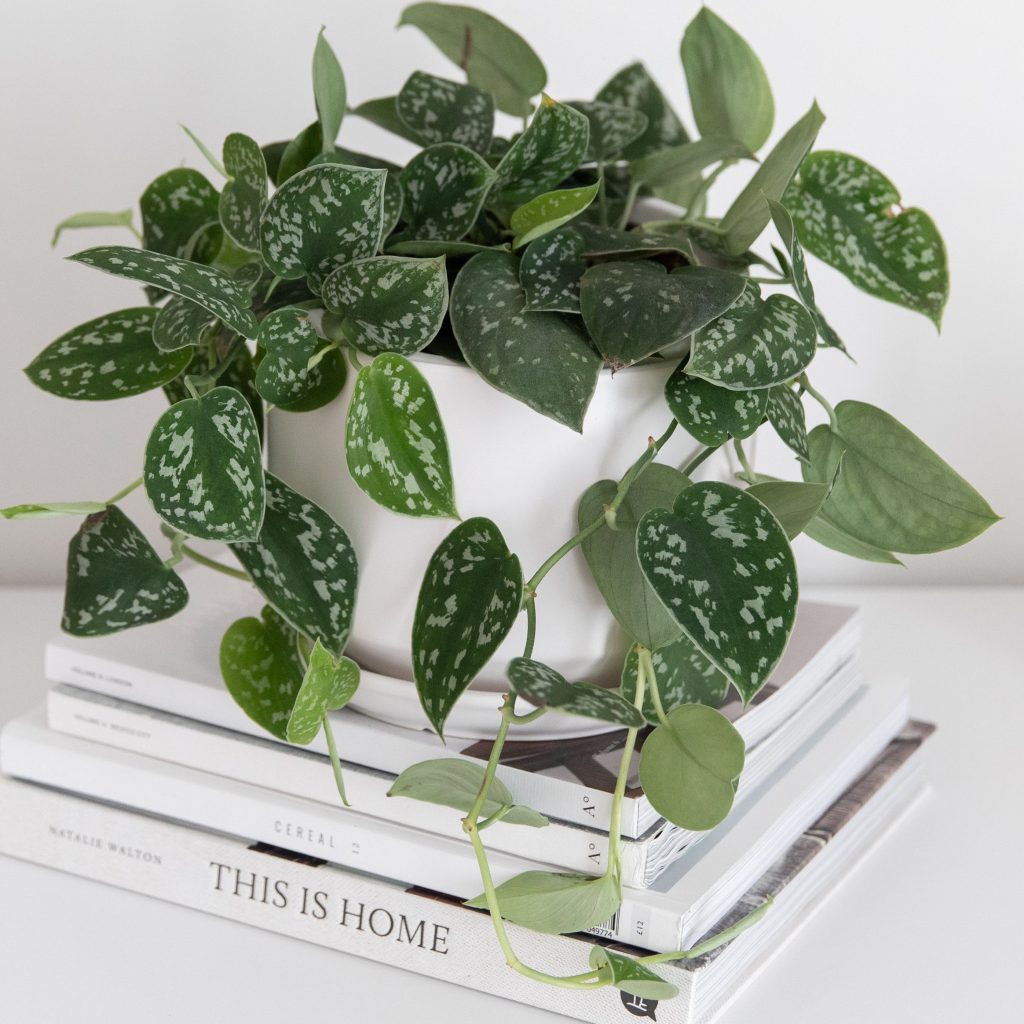
The Scindapsus Pictus plant is often sold as at Satin Pothos. It is the most popular of the Scindapsus varieties.
The topmost layer of the Scindapsus has a suede-like texture. Their dominant colors are green with splotches of white. However, their underside is a lighter hue of green color. An interesting feature of this variety is it glitters when exposed to light.
Although the Scindapsus Pictus is quite resilient compared to other house plants when exposed to unfavorable growth conditions, their plant’s growth can be inhibited and the effect can become visible on the foliage appearance of the plant.
The issues or conditions that the Scindapsus plant is susceptible to are usually attributed to a deficiency in a growth requirement which may be adequate watering, organic soil, appropriate temperature, well-drilled container, and proper lighting. Some of these issues include:
I. Root Rot
This is a condition that happens when the soil is waterlogged and this is usually due to overwatering. This problem affects the foliage color of the plant as the leaves would start turning yellow.
II. Yellow Leaves
Several factors contribute to the leaves of the Scindapsus variety turning yellow, a total offside from the original foliage color of the plant which is Green and White. The major causes of this issue are the under-watering of the plant and constant exposure to direct sunlight. This issue can be averted if the plant is moderately watered persistently or if the plant’s container is situated in a shaded area.
III. Drooping leaves
This sign is easily detectable as you would see visible signs of your plant losing its vigor. This issue is typically caused when the plant is deprived is situated in a poorly lit environment. Your plant should be situated where it would receive bright indirect sunlight.
IV. Brown/Dried leaves
This typically happens when the plant is constantly exposed to harsh sunlight. The effect of exposure to direct sunlight is the edges of the leaves would start turning brown or the leaves would start appearing burnt. After a while, the leaves would start dropping. This can be averted if the plant is kept where it can receive medium light.
2. Silvery Ann
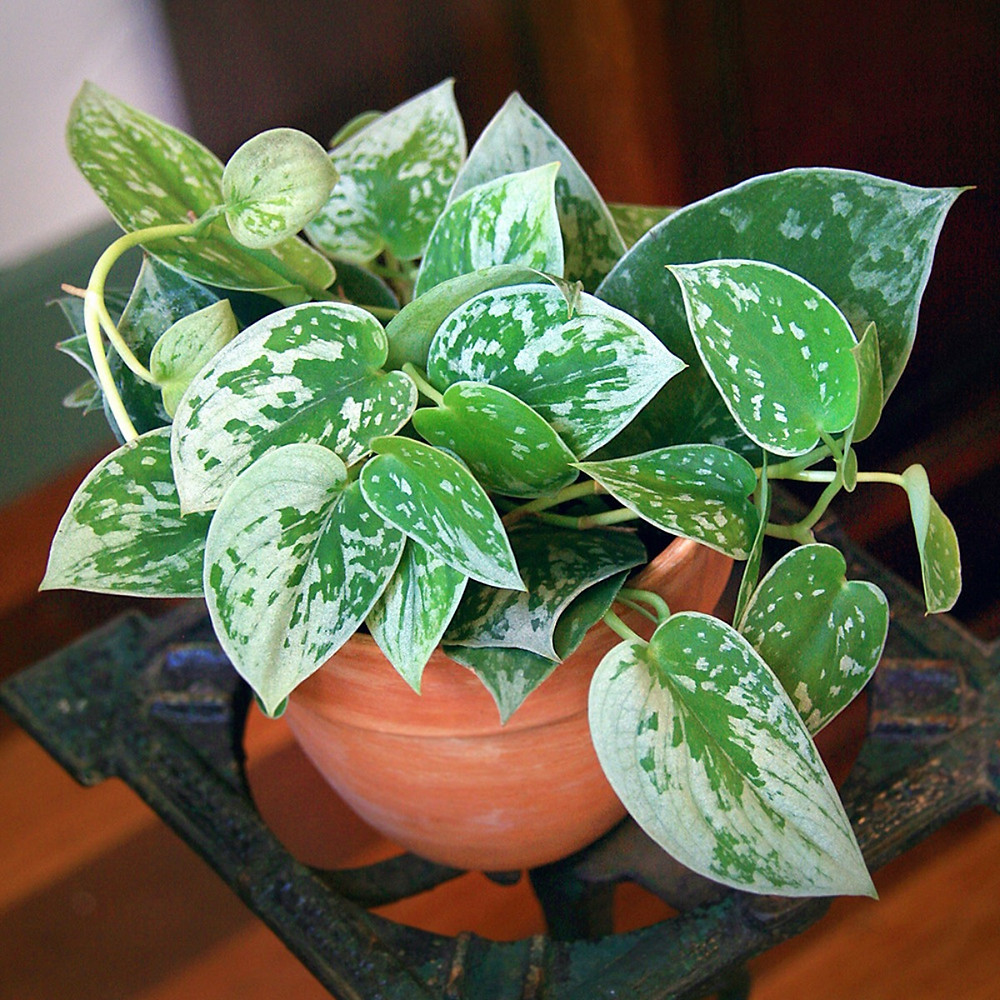
The Silvery Ann is similar to Scindapsus Pictus but the major difference is the prominence of the silver foliage color. The Silvery Ann Scindapsus can be propagated in three (3) different methods. These methods include:
I. Stem Cutting
This is regarded as one of the easiest methods of propagating the Scindapsus variety. All you need is clean scissors, a Scindapsus plant, and a jar of water. All you require is to make the cutting a few centimeters below the node and put the cutting in the jar of water.
Change the water consistently for aeration and speedy growth. Once you notice notable root growth, transplant into a pot/container.
II. Side Shoot Cuttings
This method includes you taking side pups from the Silvery Ann mother plant. Place the side pup into a container filled with organic soil and insert the root deeply.
III. Leaf Vein cutting
Although this method seems more difficult than the others, you should be able to swing it with a few tutorials. For this method, all you require is to take a leaf from the Silvery Ann plant and snip it off.
Place the lead face down so that its vein is visible then cut the leaf into segments (all segments that would be cut out must include a section of the main vein). Then place the cutting upwards on the surface of organic soil and secure it with a pin. Wait for the roots to develop before transplanting.
Regardless of any method used, the plant still requires utmost care and attention before being transplanted.
3. Jade Satin
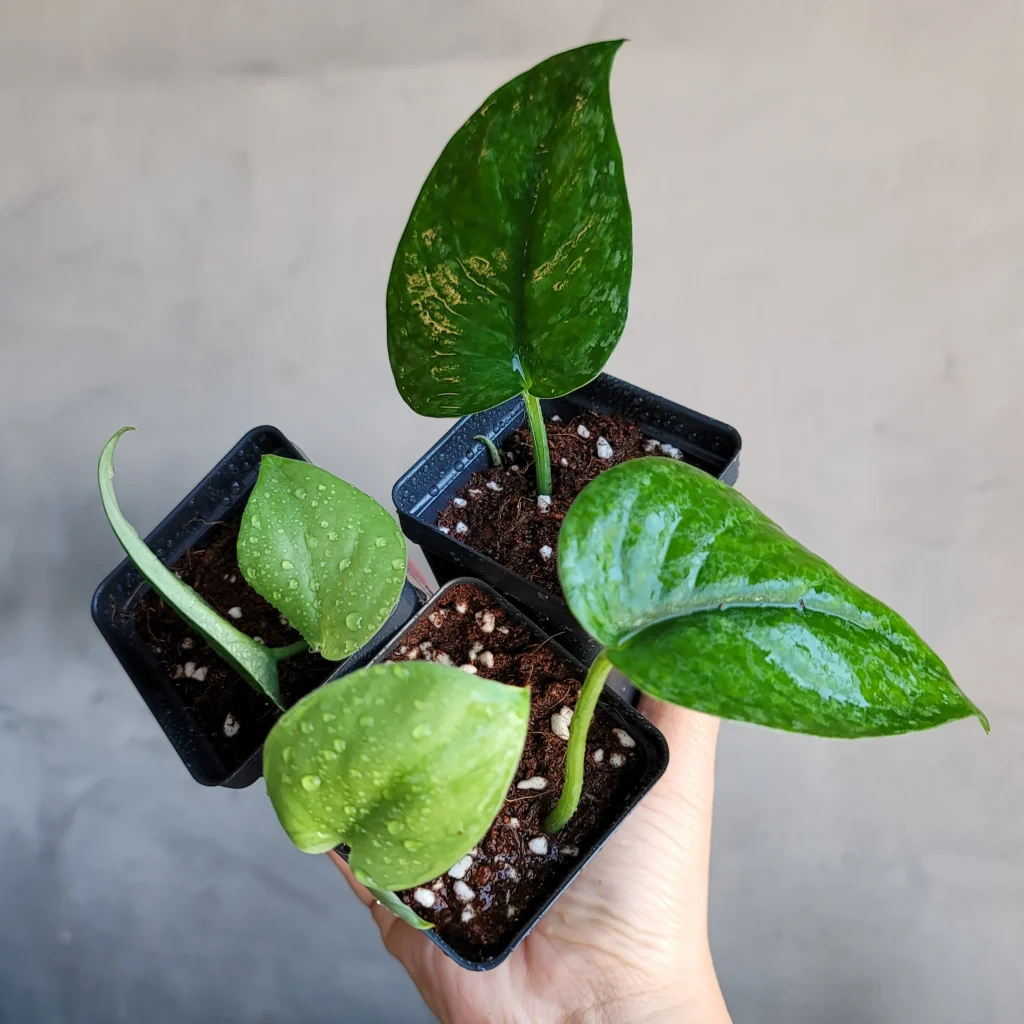
The heart-shaped Jade Satin variety has thick dark green leaves. Unlike other varieties of the Scindapsus plant which has splotches and streaks of either white or silver, the Jade satin’s prominent color is plain green/emerald with a veined pattern as foliage design.
Their crawling features make them an excellent choice for wall covers especially garden walls. The basic requirements of the Jade Satin include light, water, humid environment, adequate temperature, proper soil, and appropriate container.
I. Light
The Jade Satin variety thrives in bright indirect light the appropriate lighting condition they should be exposed to is medium-light. Your Jade Satin should be kept in a shaded area where it can still receive an adequate amount of sunlight.
Exposure to harsh heat from direct sunlight can damage the foliage appearance of the plant. The effect of exposure to direct sunlight would take a toll on the leaves by a change in foliage color. Some of the warning signs of excess exposure are brown and dried leaves; the leaves would appear burnt.
To prevent further damage to other leaves, change the position of the container and place it in a more shaded area.
II. Water
Moderate watering is needed for the Jade Satin to thrive. Watering that leads to waterlogged soil should be avoided as this makes the plant susceptible to root rot which can always be identified by the rotten smell from the soil and yellow leaves.
III. Soil mix
The appropriate soil mix for this variety is Organic soil mix which can be ordered or purchased from nearby or online stores.
IV. Potting
The container used in potting the plant should be well drilled to allow good drainage of water that would prevent soggy/waterlogged soil.
4. Scindapsus Treubii Moonlight
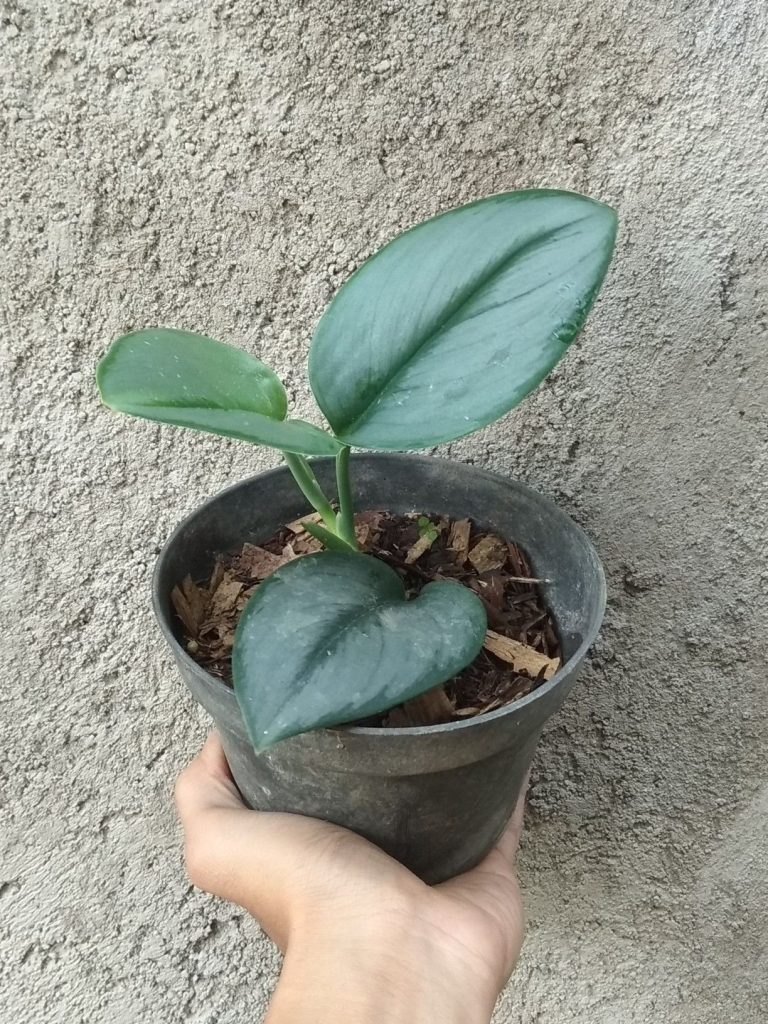
The Scindapsus Treubii is a heart-shaped plant with a sharp tip. The foliage color is a combination of Emerald and Silver.
It is popularly referred to as the “Sterling Silver”. This variety thrives in tropical regions and is common in Southeast Asia. Since they are crawling plants, they are mostly grown outdoors in nursery beds until they find a tree to climb; this does not imply they cannot be grown outdoors.
For their growth, all they need is adequate provision of light, water, organic soil, fertilizer, pole/tree when the plants start crawling and appropriate temperature. Since this plant is a crawling/climbing plant, its growers may find caring and pruning it a tedious task. We have provided a few tips you can note for the Sterling Silver plant.
- Erect/ secure a framework your Sterling Silver plant can latch on to or twine around while growing.
- Water the soil regularly but never allow the soil to dry out.
- If you desire, restrict the trailing stems to a certain shape and space by persistently untangling while the plant is still young and train the plant to your desired shape and space.
- If certain parts of the plant appear damaged, snip off the affected parts to encourage and enhance new growth.
- Regularly check if your plant is receiving adequate sunlight because when mature some parts of this plant tend to be deprived of light than others.
If grown indoors, select an attractive container that would complement your “Sterling Silver”. In addition, place the pot in a location where it would accent the outlook of your home. To serve its purpose of beautifying the environment, it should not be kept in hidden locations.
5. Scindapsus Platinum
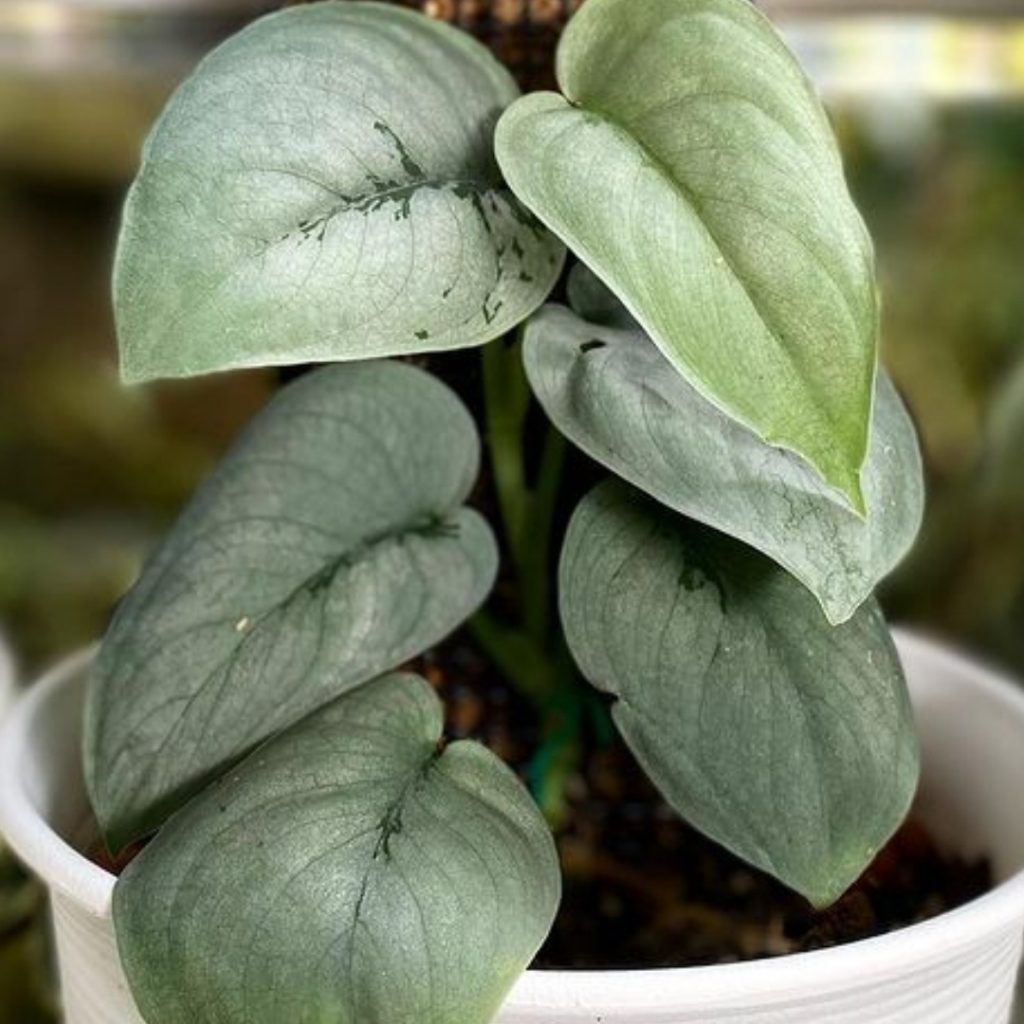
This variety is quite similar to other heart-shaped Scindapsus plants only that their heart shape starts at the edge rather than the center like most Scindapsus plants. The prominent color of the Scindapsus Platinum is silver and every part of this variety is usually silver or gray. They are amongst the rare varieties of the Scindapsus plant so they may be more expensive than other varieties.
They have thick and crunchy-like leaves and so cannot be easily damaged by wind. The basic requirements of this plant are water, light, well-drilled containers to prevent waterlogged soil, fertilizer to enhance growth, and an appropriate temperature. The appropriate temperature for the Scindapsus Platinum to grow is 65 °F-75 °F.
During extreme weather conditions, they must be kept indoors. During winter, remember to reduce watering as their roots become tender during this season and they are prone to root rot.
The Scindapsus Platinum usually has a hard time recovering if it develops a plant issue during winter especially when it has been exposed to harsh weather conditions for a while. If grown outdoors, ensure they are kept in properly shaded areas as they are susceptible to damage from the harsh heat of direct sunlight.
The signs of exposure to direct sunlight become visible when the leaves start having brown edges before the whole leaf is affected and falls off. Growers must bear in mind that although fertilizers enhance the growth of the Scindapsus Platinum, the application can become detrimental to the growth of the plant.
If the leaves of your plant start turning yellow, stay off fertilizing for a while till the root recovers and if there is no improvement, consider repotting the plant.
6. Scindapsus Silver Hero
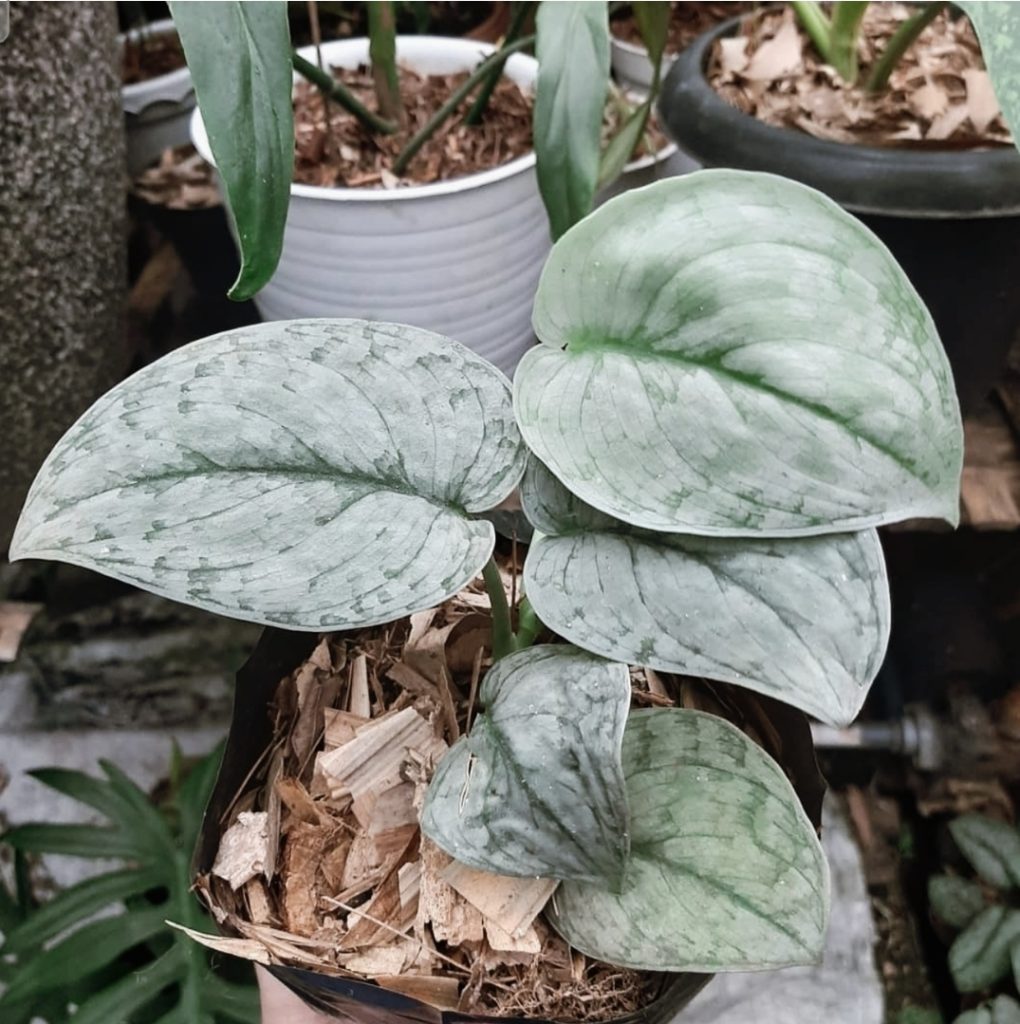
This variety is among the most popular Scindapsus plant and is common in nurseries and online stores. For Scindapsus growers, the Scindapsus Silver Hero tops their list because they are an easy maintenance plant that would thrive regardless of your schedule so far they are not neglected for an extended period.
The Scindapsus silver hero is quite similar to the Scindapsus platinum only that the Scindapsus silver hero has streaks of green, unlike the Scindapsus platinum which is plain silver.
This plant tends to become bushy when mature; this means the grower must ensure that every part of the Scindapsus Silver Hero receives adequate light and water because once they become bushy some parts of the plants would be deprived of these nutrients and would start to die slowly.
The grower must ensure there is an even spread of water, light, and fertilizer for the proper growth of the plant.
If you notice your Scindapsus plant is turning brown, this is a sign of under-watering and over-fertilization. Your Scindapsus Silver Hero would start to droop or wilt if it is not kept in a well-lit environment; this implies there must be a provision of proper lighting.
If natural light does not suffice, make use of artificial light. As earlier mentioned, since this plant can become bushy, the growth can be reduced by regularly trimming/pruning the plant to maintain your desired shape.
Final Thoughts
Any of the varieties of the Scindapsus plant is a great option for either indoor or outdoor propagation. Since all their growth requirements are the same, some just need a greater measure than the others, ensure that your selected option must be tended to and adequately catered.
The major threat to the Scindapsus plant is neglect for an extended period. Modify your schedule to suit the growth requires and you are sure to have a thriving plant.

